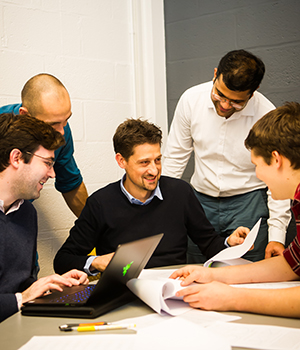
Emilio Baglietto
(he/him)
Nuclear Science and Engineering
Making the connection
Professor Emilio Baglietto’s “unparalleled enthusiasm” for teaching is both contagious and formative of his students’ academic development. “It was during his class that I felt I actually became a nuclear engineer,” one of his advisees remarked.
Over the six years that Baglietto has spent in the MIT Nuclear Science and Engineering Department, he has made an impression on his graduate students as both an excellent model of a senior scholar and as a supportive and encouraging advisor. He is described by his students as an “extraordinary research advisor and a genuinely kind person, [who] is deeply committed to the personal wellbeing and professional development of each member in his research group.” It is for these reasons that Baglietto was selected as a winner in the latest round of MIT’s Committed to Caring (C2C) award.
Maximizing potential
Baglietto is the Associate Professor of Nuclear Science and Engineering at MIT. A leader in computational fluid dynamics (CFD) technology, his research areas include turbulence modeling, unsteady flow phenomena, multiphase flow and boiling, and virtual reactor modeling. The techniques he develops and teaches to his students help to improve the safety and efficiency of nuclear fission technology. Baglietto earned his MS in Nuclear Engineering from the University of Pisa in 2002, and his PhD in Nuclear Engineering from the Tokyo Institute of Technology in 2004.
Before coming to MIT, Baglietto worked in the nuclear engineering industry and cites this experience as being highly influential of his teaching and research style. All research projects that Baglietto undertakes in his lab have real world applicability, and he trains his students to be prepared for life in the industry after MIT. One student noted that “Professor Baglietto is fully invested in our well-being and future ability to make meaningful contributions to the field.”
Baglietto’s advisees say he is especially dedicated to helping his students make connections with the broader field of nuclear engineering. This type of informal advising (a precept that is one of the Mentoring Guideposts identified by the C2C program) helps students to feel well-grounded and sufficiently prepared for the future. One student recounts that Baglietto “consistently encourages everyone in our research group to network broadly, and has funded our entire group to attend some of the top international research conferences. He is truly committed to our professional growth and development.”
Baglietto is skilled in the cultivation of young engineers, and encourages them to determine their own course. He says that he does not have ‘predesigned’ projects from sponsors that he assigns to the students; instead, he uses a student’s first few semesters to identify their strengths and works with them to create a research trajectory. Baglietto remarks, “We all have strengths and weaknesses, or even things we like more or less. It is key that students are able to design their own research paths.”
Forging one’s own path is not always easy or expected in academia. Baglietto recalls that the hardest moment in his own graduate school experience was when he decided to entirely change his research methodology. “After 18 months of research, I had to tell my supervisor that I had abandoned the approach he had suggested and instead picked up a different direction in Computational Fluid Dynamics. I tried to make sure I had done my homework in order to convince him I had a good idea and that it was worth pursuing.” He says, “I cannot say my supervisor wasn’t surprised at first, but it did end up working out well.”
Cultivating a healthy lab environment
Along with his ambitious lab-wide aims, Baglietto has prioritized fostering a friendly and inclusive work environment (another of the Mentoring Guideposts). One of Baglietto’s students noted in their nomination letter that “he creates a collaborative environment in which it is understood that each person’s opinion must be treated with respect, and that each individual contributes value to the research group as a whole.”
Baglietto says that one of the central practices he encourages in his lab–and a tenet he learned from his middle school math teacher–is “to enjoy competition.”
“Research is not that different from sport, so don’t be afraid of competing. Go out and challenge other groups with your ideas, make it fun,” Baglietto urges. “See if your ideas actually work in the field…and never be afraid of challenging yourself and your ideas!”
When asked what advice he would give to incoming graduate students at MIT, Baglietto offers, “The best thing you can do is be completely transparent with your faculty advisor. Tell them what your goals are. And communicate any worries or fears about reaching them.”
To his own students, he says, “Do not underestimate your potential. Push yourself; you are capable of much more than you can imagine. Never settle for the simple solution, aim as high as you can, and maybe a little bit above that. My role is to be your safety net, so you should never be afraid to fail.”
